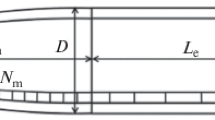Abstract
Root axes of tomato (Lycopersicon esculentum) were cultured in vitro in three different concentrations of sucrose in order to vary their growth rate. Lateral root growth and the initiation of lateral root primordia were studied on each group of axes. Various aspects of primordium initiation, positioning, and emergence were quantified with a view to discovering variable and constant features of these processes. Variable parameters were the rate and frequency of root primordium emergence. Constant parameters, at least under the prevailing conditions, were the spacing between successive laterals and primordia, and the position of the primordia in relation to the vascular system. A model of primordium initiation is presented which combines controls determined by the divisional history of the potential primordium cell and by the vascular pattern.
Similar content being viewed by others
References
Aung, L. H., 1982: Root initiation in tomato seedlings. — J. Amer. Soc. Hort. Sci.107, 1015–1018.
Barlow, P. W., 1984: Positional controls in root development. — InBarlow, P. W., Carr, D. J., (Eds.): Positional Controls in Plant Development, pp. 281–318. — Cambridge University Press.
—, 1987: Cellular packets, cell division and morphogenesis in the primary root meristem ofZea mays L. — New Phytol.105, 27–56.
-Adam, J. S., 1988: Meristems, metamers and modules in the development of shoot and root systems. — InIqbal, M., (Ed.): Growth Patterns in Plants. — In preparation.
Bernatzky, R., Tanksley, S., 1986: Majority of random cDNA clones correspond to single loci in the tomato genome. — Mol. Gen. Genet.203, 8–14.
Blakely, L. M., Rodaway, S. J., Hollen, L. B., Croker, S. G., 1972: Control and kinetics of branch root formation in cultured root segments ofHaplopappus ravenii. — Plant Physiol.50, 35–42.
Bonnett, H. T., Jr., 1969: Cortical cell death during lateral root formation. — J. Cell. Biol.40, 144–159.
Böttger, M., 1978: Levels of endogenous indole-3-acetic acid and abscisic acid during the course of the formation of lateral roots. — Z. Pflanzenphysiol.86, 283–286.
Chiang, S.-H., Gifford, E. M., Jr., 1971: Development of the root ofCeratopteris thalictroides with special reference to apical segmentation. — J. Indian Bot. Soc.50 A, 96–106.
Cutter, E. G., Feldman, L. J., 1970: Trichoblasts inHydrocharis. I. Origin, differentiation, dimensions and growth. — Amer. J. Bot.57, 190–201.
Hackett, C., Stewart, H. E., 1969: A method for determining the position and size of lateral root primordia in the axes of roots without sectioning. — Ann. Bot.33, 679–682.
Hannay, J. W., Street, H. E., 1954: Studies on the growth of excised roots III. The molybdenum and manganese requirement of excised tomato roots. — New Phytol.53, 68–80.
Lück, J., Barlow, P. W., Lück, H. B., 1987: Cell genealogies in a plant meristem deduced with the aid of a bootstrap L-system. — In preparation.
Mallory, T. E., Chiang, S.-H., Cutter, E. G., Gifford, E. M., Jr., 1970: Sequence and patterns of lateral root formation in five selected species. — Amer. J. Bot.57, 800–809.
Maxon Smith, J. W., Ritchie, D. B., 1983: A collection of near-isogenic lines of tomato: research tool of the future? — Plant Mol. Biol. Rep.1, 41–45.
Noll, F., 1900: Über den bestimmenden Einfluß von Wurzelkrümmungen auf Entstehung und Anordnung der Seitenwurzeln. — Landwirtschaft. Jahrb.29, 361–426.
Rick, C. M., 1974: The tomato. — InKing, R. C., (Ed.): Handbook of Genetics 2, pp. 247–280. — New York: Plenum Press.
Sharman, B. C., 1943: Tannic acid and iron alum with safranin and orange G in studies of the shoot apex. — Stain Technol.18, 105–111.
Street, H. E., McGregor, S. M., 1952: The carbohydrate nutrition of tomato roots III. The effects of external sucrose concentration on the growth and anatomy of excised roots. — Ann. Bot.16, 188–205.
Torrey, J. G., 1986: Endogenous and exogenous influences on the regulation of lateral root formation. — InJackson, M. B., (Ed.): New Root Formation in Plants and Cuttings, pp. 31–66. — Dordrecht: M. Nijhoff.
Tschermak-Woess, E., Doležal, R., 1953: Durch Seitenwurzelbildung induzierte und spontane Mitosen in den Dauergeweben der Wurzel. — Österr. Bot. Z.100, 358–402.
—, 1953: Über Musterbildung in der Rhizodermis und Exodermis bei einigen Angiospermen und einer Polypodiacee. — Österr. Bot. Z.100, 646–651.
Weston, G. D., Street, H. E., 1968: The effects of 1-naphthylacetic acid on the growth of excised tomato roots. — J. Exp. Bot.19, 628–635.
Zobel, R. W., 1974: Control of morphogenesis in the ethylene-requiring tomato mutant,diageotropica. — Canad. J. Bot.52, 735–741.
—, 1986: Rhizogenetics (root genetics) of vegetable crops. — Hort. Sci.21, 956–959.
Author information
Authors and Affiliations
Additional information
Dedicated with great respect to Prof. DrElisabeth Tschermak-Woess on the occasion of her 70th birthday in recognition of her distinguished contributions to cytology.
Rights and permissions
About this article
Cite this article
Barlow, P.W., Adam, J.S. The position and growth of lateral roots on cultured root axes of tomato,Lycopersicon esculentum (Solanaceae). Pl Syst Evol 158, 141–154 (1988). https://doi.org/10.1007/BF00936340
Received:
Issue Date:
DOI: https://doi.org/10.1007/BF00936340




